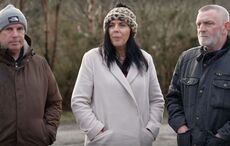ON August 7, 1974 a man stepped out on a thin high wire tied between Manhattan’s famous Twin Towers. Phillipe Petit, a skinny French tightrope walker, cast a rope between the two buildings of the World Trade Center with a bow and arrow in the night, and his illegal, crazy but ultimately successful walk between the two iconic buildings would eventually come to be called the art crime of the century.
For Dublin-born writer Colum McCann, 44, Petit’s daring 1974 tightrope walk was a jumping off point, irony intended, a way to talk about New York, the Twin Towers and the people of the city and what they mean to him, without instantly conjuring up images of sirens and dust and devastation.
Petit’s tightrope walk was all the remove that McCann -- who started out as a journalist for Dublin’s Irish Press in 1985 -- needed, the critical distance that gave him the objectivity to write about our own time, our own city, and our own Twin Towers.
In "Let the Great World Spin" (Random House), McCann writes about Petit’s 1974 high wire walk so vividly that at times he produces a sense of looming vertigo -- not only are we astonished at Petit’s courage, we also know, behind it all, that the towers themselves will eventually fall.
So reading McCann’s book is like looking at a double exposure. You can see the past and the present intermixed, but so deftly that its becomes hard to tell one from the other.
“I have vertigo and I can’t walk more than one or two feet in the air,” McCann, who now teaches creative writing at New York’s Hunter College, says.
“So the idea of standing on a rope a quarter of a mile up in the sky was quite extraordinary to me. Just the weather alone, the wind that’s created up there, and the fact that the buildings themselves swayed in the breeze.
“If they swung in the wrong direction or if the wire contracted at any time Petit could have bounced up into the air. He had to get the tension in the ropes right. It’s kind of a miracle that everything came together at once and he managed to go from one side to the other. He did it eight times. He even lay down on the wire at one point, which is extraordinary.”
Thinking about the very real possibility of Petit falling reminds us of how much our minds are guided by those people who did fall on 9/11. Even though there were 27 years between the two events, the images linger indelibly. So McCann’s new book addresses 9/11 by looking at it askance, from another era.
“That’s the perfect way to put it. Many novels, films, poems, screenplays will go to the heart of the matter. Shortly after 9/11 it struck me that meaning was already being structured, it was coming down in a certain way,” he says.
“I remember a child’s drawing of the two towers holding hands; it was poignant as any work of art. The fact that there was no eyewash on the supermarket shelves on the day after 9/11 seemed to have as much meaning as anything else, I thought. In other words, everything was sort of poignantly connected.”
But poignancy and heartache on that scale are not a good place for an artist to be. To rescue himself, McCann went back almost 30 years to see how it instructed the present. To place the Twin Towers back into the city’s story was what McCann was thinking of.
“Vietnam folds over, to some extent, Iraq. Questions of faith then fold over to now. Ineffectual presidents are judged, forced to resign,” he says.
“So choosing 1974 instead of 2001 was a way to talk about an act of creation rather than destruction. The moment that Petit, the tightrope walker, has is a moment of grace and reconciliation, even a moment of beauty.”
In McCann’s new book, the opening scene, high up on the wire between the Twin Towers, turns almost reflexively to an imaginary Dublin childhood in the 1950s. It’s as if McCann, like Oisin in the old Irish myths, decides to return and briefly touch his native soil to gather himself for the arduous journey ahead of him.
“I wanted to shock myself as much as anything else. I haven’t gone back to Dublin for many years in terms of writing a novel, and I loved the transition from being up on the wire and falling back to find yourself on Sandymount Strand,” he says.
“It just felt right to me. I kind of wanted to shock myself into examining where all these moments in the novel come from.”
McCann’s own father-in-law was on the 59th floor of the first tower to be hit (and the second one to come down).
“I still have the dust covered shoes he wore that day. I wrote an article for the Irish Voice and I mentioned them in it. He knew straight away that it was a terrorist attack because he had been there for the previous attack in 1993,” McCann says.
“So he just gathered up his stuff and went down the stairs with the thousands of others who were doing likewise.”
While he was still inside the neighboring building came down. All the young firefighters, the cops, men and women, were still going up the stairs, in an orderly fashion. But he got out, waded through the pools of water and then out into a white land of fire and ash.
“He made his way all the way to 71st Street and First Avenue where we were living at the time. My young daughter smelled the dust and smoke on his suit and thought he was burning,” recalls McCann.
“When she was told he was not she said, ‘No he is, he’s burning from the inside out.’ He threw his shirt and suit down the garbage disposal and he left his shoes at out door.”
McCann’s father in law said he would never read a 9/11 novel or see a film about it. It brought back too much for him. He still, McCann says, wakes up having seen the faces of those kids going up the stairs as he went down.
“When he read Let the Great World Spin he realized right away that it was about 9/11, but he also understood that it was a different story, it was about 1974, too,” McCann says.
“It’s about joy and accomplishment and beauty. It was a way for me to try and tell the 9/11 story and yet get out of it on a different note.”
It might surprise some to learn that this most philosophical of writers thoroughly loves the public readings and book launches that most writers bemoan.
“I should say I don’t, because it doesn’t sound very serious, but I love meeting people and I love getting out and about. I sit on my ass for long periods of time. It’s a solitary thing. I’m a pretty social being,” he says.
McCann’s new book was rapturously received by Oprah Winfrey’s Book Club, which can be a fast track to bestseller status, but McCann’s not overawed.
“If you believe the good stuff you must also believe the bad stuff. It’s a natural, logical corollary. Therefore you just say that’s wonderful that happened but I must move on. My own literary heroes manage to keep their life and art in check.”
Fellow writer Dave Eggers recently observed, “Leave it to an Irishman to write one of the greatest-ever novels about New York.”
As for "Let the Great World Turn" and its abundant metaphors, McCann’s hopes are as modest as his skills are wide.
“I want people to walk inside it. If they choose to see it about 1974 that’s cool. If they choose to see it as an 9/11 allegory that’s even cooler,” he says.
“I hope it breaks their hearts in a certain way. It was the easiest book that I’ve written in a while, but it knocked the living s*** out of me.”




Comments